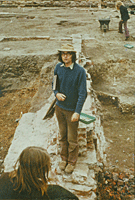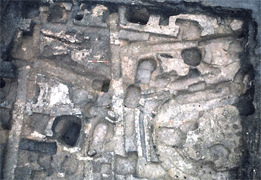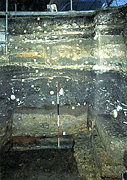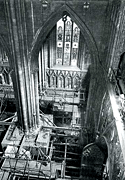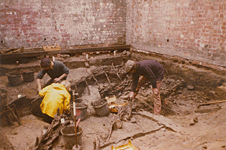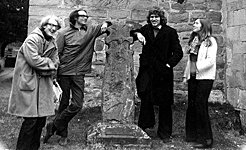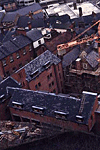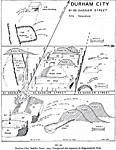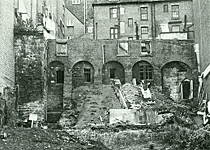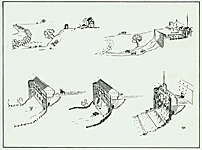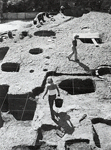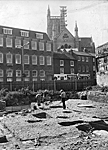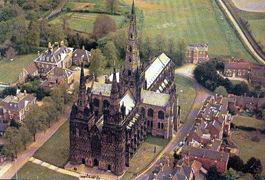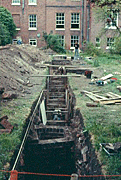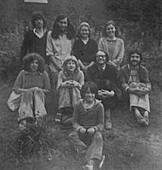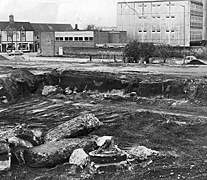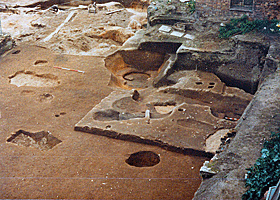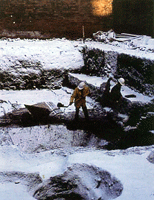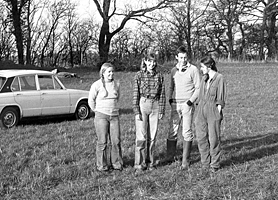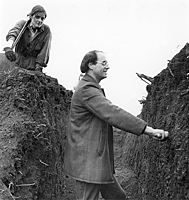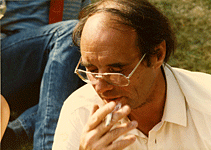Towns
Contents:
- Winchester
- York Bishophill
- York Minster write-up
- Durham
- Shrewsbury
- Worcester
- Lichfield
- Stafford
- Thinking about towns
Martin's first, and continuing, interest is towns, not just as archaeological challenges, but as places for living. The early 1970s were an exhilarating time for urban archaeology and Martin, after volunteering on Martin Biddle's excavations in Winchester, jumped at the opportunities offered by urban regeneration in York, Durham and a series of towns in the West Midlands. These campaigns in the 1970s and 1980s led to the formulation of a framework which attempts to combine the physical properties of the deposits with both the research agenda and the value that citizens place on their living and working space: evaluation and project design. He developed his ideas in France ('Forty French towns', 1983) and brought them to maturity in the 1990s in York (York development and archaeology, 1991; Arguments in stone, 1993).
Digging towns was an adventure; some photographs would horrify Health and Safety officers today. But it was Martin's ability to come up with the most imaginative solutions on site, coupled with his facility for convincing anyone of almost anything that made working on his sites so exciting.
Winchester
Yet to be released from the Army in 1971-2, Martin began volunteering on Martin Biddle's excavations in Winchester. Long-haired and scruffy, but still legitimately wearing his Army jacket, he attracted Biddle's scorn for being a hippy in ex-Army kit showing no respect for the uniform. But once the misunderstanding was cleared up, Biddle became an influential early mentor and later supporter.
Martin (Carver) recalls in Rescue News (2006):
"Actually my first job was to mend the windows of an old school so it could be used as finds hut, but I was allowed on site after a week. A few days later I volunteered for work at the sharp end: a contractor preparing a site for building had encountered the Roman south gate and was having trouble getting its excellent 1900 year old concrete to shift. That gave us a week or so to dig. Working in a small team up against the clock was a thrill (...); Biddle, on site with us, infecting us with the pleasures of discovery, as the pile of broken stone between the piers of the Roman gate gradually declared itself as a 10th century Anglo-Saxon blocking wall."Back to top
York Bishophill
After this first encounter with urban archaeology, Martin was invited in 1973 by Peter Addyman - for whom he had worked at Chalton - to join him at the newly-formed York Archaeological Trust to supervise the excavation of Bishophill. This Roman site with (public?) buildings of the 2nd-3rd centuries had been thoroughly robbed and cut up by medieval and later pits and buildings, providing good training in the craft of urban archaeology under Peter Addyman's generous guidance.
Peter Addyman writes:
Carving up Bishophill
"Martin Carver was an early recruit on the excavating staff of the York Archaeological Trust. From a standing start in 1972 the Trust pitched into a huge number of threatened archaeological sites in and around York. Diggers were recruited wherever they could be found and included students from all over the world. Supervisors were needed to marshal them into excavating teams, formulate excavation strategies and carry out complicated excavations in often deeply stratified urban deposits. This motley though convivial army was housed in communal hostel accommodation of the most rudimentary sort.By 1973-4 both Martin Carver and Madeleine Hummler were part of the York effort, Martin as a supervisor and Madeleine as an expert student digger from Switzerland. They worked on different sites, Madeleine on a huge urban cemetery belonging to the lost church of St Helen-on-the-Walls in Aldwark.
Martin, however, eventually became officer commanding a quite different excavation, a block of urban landscape on Bishophill, south west of the river Ouse. Here there was deep stratification the upper part of which comprised innumerable medieval pits and dumps, all cutting and intercutting and mainly composed of seemingly identical black sediments. Martin thought it a waste of time to try to disentangle this chaos and hammered it all off - despite imprecations, direct orders and even quite explosive sense-of-humour failures from above. He may have been right, and anyway managed to disentangle quite impressive if heavily robbed Roman buildings at the base of it all.
Martin's urban archaeology experience in 1970s York stood him in good stead - but not half so good as the life partner Madeleine whom he recruited from York."
PETER ADDYMAN
References (MOHC bibliography)
- 1976. [Roman, medieval and post medieval structures at Bishophill] in P.V. Addyman Excavations in York 1973-1974: second interim report: 2-5, 12, 15-17, 25. York: York Archaeological Trust.
- 1978 (with S. Donaghey & A. B. Sumpter). Riverside structures and a wall in Skeldergate and buildings in Bishophill (The Archaeology of York - the Colonia, Volume 4, fascicule 1). London: Council for British Archaeology.
York Minster write-up
Upon returning to York to head its University Department of Archaeology in 1986, Martin was able to play a part in the publication of the jewel of York, the Minster. Derek Phillips and the entire archive of the 1960s excavations under York Minster were lodged in Micklegate House, the (then) home of the Department of Archaeology. Derek was a brilliant excavator but swamped by the sheer volume of records. With Martin's encouragement and editing, and diplomatic liaison with the Royal Commission on the Historical Monuments of England, and thanks to Brenda Heywood's meticulous research, Volume 1 of York Minster was published in 1995.
Martin contributed an interpretation of the York Minster sequence from Roman fortress to Norman cathedral in the volume.It offers not one interpretation, but three - the second being his preferred model. Model A proposes that there is no occupation between the 5th and 8th centuries; Model B suggests sub-Roman activity in the basilica and the centurions' quarters, but no early Anglian phase, with occupation returning in the 9th century in an Anglo-Scandinavian Minster precinct; Model C (that put forward by Phillips & Heywood) posits that there is continuous occupation, but much change of use, between the 5th and 9th centuries.
References (MOHC bibliography)
- 1995 (ed.) (with A.D. Phillips & B Heywood). Excavations at York Minster. Volume I: from Roman fortress to Norman cathedral. Royal Commission on the Historical Monuments of England.
- 1995. Roman to Norman at York Minster, in M.O.H. Carver (ed.) Excavations at York Minster. Volume I: from Roman fortress to Norman cathedral: 177-221. Royal Commission on the Historical Monuments of England.
Durham
While a postgraduate at Durham in 1973, Martin was soon distracted from his research on Anglo-Saxon manuscript illustrations, at New Elvet in Durham and in Bishop Auckland. Both sites provided opportunities to pick up a moribund site or archive, arrange further investigation and bring it to publication.
If these interventions could still be conducted while pursuing research in the library, things changed in 1974 with the excavation of an urban sequence on the Castle mound and at Saddler Street. The excavation of three Late Saxon tenements with bow-sided buildings and middens deep under the fabric of Durham, with excellent preservation of organic remains, proved decisive. Professor Rosemary Cramp, his thesis supervisor, let him go to earn a living as a 'rescue' archaeologist. She has always been his most supportive mentor and incisive critic.
Rosemary Cramp writes:
"When I interviewed Captain Carver for a post-graduate place on the Anglo-Saxon course, I encountered an immaculate upright figure with highly polished shoes, but contact with field archaeology and its practitioners soon changed all this, as this image shows: Martin and fellow graduates [Brian Gill, Paul and Sarah Gosling] in intimate contact with early medieval sculpture."
ROSEMARY CRAMP (see also her entry under Sutton Hoo)
Saddler Street posed a logistical challenge. The excavation of the three adjacent cellars, with the British Legion building towering menacingly more than 10m above, left no room for spoil heaps. So a motorised winch was hired which lifted every single wheel-barrow three floors up to be dumped in the hall above. There were a couple of narrow scrapes, when the shoring of the castle trench was temporarily loosened and the sides collapsed, and when a reinforced glass window came crashing five floors down, fortunately on the team's day off.
The 4-months campaign resulted in a remarkable sequence, modelled here in Martin's sketch in Medieval Archaeology (1979). Working on the stratigraphy and the material culture of Saddler Street was also instrumental in the formulation of firmly held, and strongly advocated, principles of recording and analysis. Contexts, features and structures, approaches to seriation and deposit modelling have become a frequent topic of publication - and sometimes controversy.
References (MOHC bibliography)
- 1974. Excavations in New Elvet, Durham City, 1961-73. Archaeologia Aeliana 5th series 2: 91-148.
- 1975. Durham: dating the Saxon settlement. The Times 9 January 1975.
- 1976 (with P.F. Gosling). The archaeology of Durham City, in D. Harding (ed.) Archaeology in the North: report of the Northern Archaeological Survey: 132-45. Newcastle: Northern Archaeological Survey & HMSO.
- 1978. Deanery buildings at St Andrew Auckland, Co Durham. Transactions of the Durham and Northumberland Architectural and Archaeological Society 4: 81 84.
- 1979. Three Saxo-Norman tenements in Durham City. Medieval Archaeology 23: 1-80.
- 1980. Early medieval Durham: the archaeological evidence, in Medieval art and architecture at Durham Cathedral (British Archaeological Association Conference Transactions 3, 1980 for 1977): 11-19.
Shrewsbury
Investigations (1972 1974) and salvage recording (1978 1980) at Pride Hill Chambers and Rigg's Hall in Shrewsbury revealed the structural history of two town houses 200m apart. Both covered part of the Late Saxon settlement at Shrewsbury and were on the course of the 13th-century town wall. They incorporated this wall in their foundations and developed between the 14th and 17th century in fine stone and timber-framed (later brick) style, as shown in Martin's sketch for Pride Hill (in Transactions of the Shropshire Archaeological Society 61).
Shrewsbury illustrates recurrent features of Carver campaigns: an ability to get on with previous investigators - in this case Ernie Jenks and Geoff Toms who had valiantly recorded Pride Hill under difficult conditions - and giving responsibility to younger team-members. Shrewsbury's publications contain contributions by many who were then starting out in archaeology, such as Jan Wills, Elaine Morris, Nigel Baker, Cameron Moffett and Sue Colledge. Pride Hill and Rigg's Hall also combined below- and above-ground archaeology, with fine building recording and analysis by Phil Clarke at Pride Hill and many others at Rigg's Hall. In the 1980s Pride Hill Chambers became a MacDonald's restaurant with a plaque recording earlier glories. Its menu featured the reconstruction drawings. Sic transit...
References (MOHC bibliography)
- 1974 (with J. Wills). Shrewsbury - the buried past: the threatened archaeology of Shrewsbury and its recovery. Shrewsbury (booklet).
- 1975. Archaeology in Shrewsbury. Rescue News 9.
- 1978. Early Shrewsbury: an archaeological definition in 1975. Transactions of the Shropshire Archaeological Society 59 (1973-4, issued 1978): 225-63.
- 1982 (ed.). Two town houses in medieval Shrewsbury: the excavation and analysis of two medieval and later houses built on the town wall at Shrewsbury (Transactions of the Shropshire Archaeological Society 61). Shrewsbury: Shropshire Archaeological Society.
Worcester
In 1976 the opportunity to excavate a sequence from Roman to late medieval within the city of Worcester presented itself at Sidbury, after Sue Hirst had recorded the town wall sequence nearby in 1975. The long hot summer was spent digging and recording Sidbury's pebble street and yards, strewn with cattle butchery remains (a Roman shambles) and 10th -17th century features belonging to tenements where bone-workers, bronze-smiths and bell-makers were active. It was difficult to obtain good overhead shots of the entire area of excavation, but the problem was overcome when Martin managed to talk the Worcester Fire Brigade into carrying out an exercise on Sidbury. They extended their ladder to full length and allowed Martin to climb to the top - not before making him sign a paper discharging them of responsibility in case of mishap.
At Shrewsbury Martin had already begun to collect data relevant to the depositional history of all archaeological remains on the peninsula, but it was in Worcester that urban evaluation was fully developed and published (1981).
References (MOHC bibliography)
- 1981. The excavation of three medieval craftsmen's tenements at Sidbury, Worcester, in Medieval Worcester - an archaeological framework (Transactions of the Worcestershire Archaeological Society): 155-219.
- 1981 (ed.). Medieval Worcester - an archaeological framework (Transactions of the Worcestershire Archaeological Society). Worcester: Worcestershire Archaeological Society.
- 1981. Introduction: an archaeology for the City of Worcester, 680-1680, in Medieval Worcester - an archaeological framework (Transactions of the Worcestershire Archaeological Society): 1-12.
- 1981. The site and settlement at Worcester, in Medieval Worcester - an archaeological framework (Transactions of the Worcestershire Archaeological Society): 15-30.
- 1981. The excavation of three medieval craftsmen's tenements at Sidbury, Worcester, in Medieval Worcester - an archaeological framework (Transactions of the Worcestershire Archaeological Society): 155 219.
- 1981. A kiln found at Diglis in 1860, and documentary evidence for potting and tiling in medieval Worcester, in Medieval Worcester - an archaeological framework (Transactions of the Worcestershire Archaeological Society): 255-60.
Lichfield
In 1977 the small band of excavators that had grown within WEMRAC took up quarters in the disused Theological College in Lichfield's Cathedral Close. The building had a reputation for being haunted. Whether you believed it or not, the place was a strange setting for excavation headquarters, reminiscent of Trollope's Warden.
Excavations were a transect in the College's garden, leading down to the Minster Pool and trenches elsewhere in the 12th century town south of the Pool, leading to publication of the evaluation of Lichfield's urban deposits in 1982, an early attempt at characterising this Mercian city, where St Chad established a seat in AD 669.
Emma Carver grew up on Martin's sites together with her brother Jay. She writes:
"This was a strange but memorable summer. We stayed in the spooky and deserted Theological College (think Scooby Doo). Our fears were put on hold by Martin's nightly episode of the epic saga of Stephen the Sheep [a story made up by Martin] at that time in its second or third year. We waved our flags as the Silver Jubilee parade passed through the Cathedral Close and the Sex Pistols were Number 1. Jay was crowned king of the lupins on a throne atop the spoil heap."EMMA CARVER
The image of the team Emma took shows from left to right, back row: Tim Yarnell, Roy Hooper, Debbie Ford, Liz Hooper; front row, left to right: Sue College, Madeleine Hummler, Martin, Mike Hodder and Jay Carver.
References (MOHC bibliography
- 1982. Excavations south of Lichfield Cathedral 1976-77. Transactions of the South Staffordshire Archaeological & Historical Society 22 (1980-1981): 35-69.
- 1982 (ed.). [The archaeology and history of early Lichfield] Transactions of the South Staffordshire Archaeological & Historical Society 22 (1980-1981): 1-129.
- 1982. The archaeology of Early Lichfield - an inventory and some recent results. Transactions of the South Staffordshire Archaeological & Historical Society 22 (1980-1981): 1-12.
Stafford
Given half a chance, Martin will grow eloquent about Stafford, a burh founded by King Alfred's daughter Aethelflaeda in AD 913. There, in 1975 (Clarke Street) and from 1979 to 1985 (St Mary's Grove and four other main sites) a large urban excavation and evaluation campaign was conducted, expanding into a survey of the urban topography and the analysis of environmental data from the King's Pool (Sue Colledge, James Greig, Lisa Moffat). Amongst highlights is the rescuing of kilns of roulette-decorated Late Saxon Stafford ware on a Sunday morning, while the developer's mechanical excavators were quiet (the kilns are at the base of the dark deposits in the section illustrated here).
Stafford was a year-round campaign, with a team supervised by Jon and Charlotte Cane. Amongst team members were Jenny Glazebrook, and Malcolm Cooper. Debbie Ford, an early student of Martin's, went to Stoke-on-Trent Museum, publishing her work on Stafford ware.
The Stafford archive and field reports were (re)compiled and the five main sequences analysed in 2008 during a sabbatical granted to Martin by the University of York. The full report is to follow, with publication by Boydell Press expected in 2011, and the archive deposited with ADS at York.
Jenny Glazebrook, who was to become the Sutton Hoo project administrator and later managing editor of East Anglian Archaeology, made her apprenticeship of field archaeology in the West Midlands and especially at Stafford. She writes:
Stafford and MA in Archaeological Practice
"Working with Martin Carver on excavations at Coleshill in the West Midlands, field archaeology suddenly began to make sense. What had seemed an opaque and rather secretive process for the first two years of my undergraduate degree became an adventure ... an expedition into the past. Further expeditions followed at Castle Farm near Shifnal, at Stafford and then Sutton Hoo. These projects were characterised by energetic leadership, strong team spirit, clear goals and a sense of purpose. Research strategy and methodology were set out at the start and developed with the team as work progressed.
During these years, responsibility was delegated in generous measure to site supervisors, who were put in charge of field projects and encouraged to put theory into practice. Some were Birmingham undergraduates completing Martin's Year Out, or postgraduates like me studying for the MA in Archaeological Practice which he established in 1982 [the photographs Jenny contributes show her and Martin at the hillfort of Nadbury, where the team of the MA in Archaeological Practice, Catrina Appleby, Cathy Royle, Andy Copp and Jenny undertook an evaluation in 1983] . I first worked in Stafford as an undergraduate, with Martin and Madeleine, toting a theodolite and staff through the streets and contributing a batch of readings to Stafftop, a topographical survey of the town centre. Later, under Martin's supervision, I would carry out a deposit modelling exercise in Stafford as my MA dissertation. Site evaluation, research design, recording system, predictive mapping, archaeological potential, urban hinterland: these were the themes of the day. BUFAU Guides evolved from 1979 to 1983, providing a comprehensive recording system for archaeological field projects, and later, forming the basis of the Sutton Hoo project record and computerised database management system. I still have my set of guides, many in Martin's own handwriting. Years later, working on a community history project, I dusted them down and they provided a timely reminder of what was required.
We were well-drilled in the idea of excavation 'powered by the urge to understand'; we knew that 'to have facts is not the same as to have knowledge' and that 'the pursuit of meaning requires targets, strategies, and methods' Underneath English towns (Carver 1987, 112). This was a theme Martin later developed in the Dalrymple lectures of 1990 (Arguments in stone, Carver 1993) and it has been for me a rewarding principle to steer by."
JENNY GLAZEBROOK
Malcolm Cooper, later to become an English Heritage inspector and then chief inspector at Historic Scotland, first became acquainted with archaeology at Stafford. He writes:
"A short story to start. I still remember vividly the great hall at my school in Stafford where we had to register for work experience following our O-levels. We had been told in our class-room earlier that day that one of the possibilities was to join an archaeological excavation in Stafford in the English Midlands. I ran to the hall to register and I spent an extraordinary few weeks excavating on the edge of the late Saxon town (and meeting many archaeologists who were to become colleagues and friends including, of course, Martin and Madeleine). After this it was inevitable that I would follow archaeology as a career - despite the strongest of opposition from my school - and that I would go to Birmingham University, the course including a 'year-out' working with Birmingham University Field Archaeology Unit then directed by Martin.
In a way this story illustrates many things about Martin. A strong interest in the past, in urbanism and in late Saxon society. An intense interest in archaeological methodology and the desire to bring an intellectual debate to what was still seen by many as simply a technical skill. But for me more importantly than all of these, an unswerving passion for helping people at whatever age or whatever their background to develop their interest in archaeology and heritage, to encourage them to challenge accepted orthodoxy, to motivate and, above all, to give them unrivalled opportunities in the profession by giving unquestioning support. Quite simply I owe my career in heritage to you Martin - have a great retirement but don't stop!"
MALCOLM COOPER
References (MOHC bibliography)
- 1981. Underneath Stafford town: an archaeological assessment. Stafford (booklet).
- 1983 (with C.B.K. Cane & J. Cane). Saxon and medieval Stafford, new results and theories 1983. West Midlands Archaeology 26: 48-65.
- Full report in preparation, to be published as Birth of a borough: investigations into Anglo-Saxon Stafford 1975-85 by Boydell in 2011.
Thinking about towns (MOHC bibliography)
This section contains bibliographical references to publications on urban archaeology not already mentioned in the site-specific references listed by towns.
- 1981. Sampling towns: an optimistic strategy, in P.A.G. Clack & S. Haselgrove (ed.) Urban archaeology in the North: approaches to the urban past: 1-28 (Durham University Occasional Paper 2): 65 91. Durham: Council for British Archaeology Regional Group 3.
- 1983. Forty French towns: an essay on archaeological site evaluation and historical aims. Oxford Journal of Archaeology 2: 339-78.
- 1983. Valutazione strategia ed analisi nei siti pluristratificati. Archeologia Medievale 10 (1983 [1984]): 49-72. Florence: All' Insegna del Giglio.
- 1984. Theory and practice in urban pottery seriation. Journal of Archaeological Science 12: 353-66.
- 1984. Archeologia urbana in Europa, in G.-P Brogiolo (ed.) Archeologia urbana in Lombardia: valutazione dei depositi archeologici e inventario dei vincoli: 9-21. Modena: Panini.
- 1984. Review of R. Shoesmith Hereford City excavations 2: excavations on and close to the defences in Antiquaries Journal 64: 176-8.
- 1987. Underneath English towns: interpreting urban archaeology. London: Batsford.
- 1987. The nature of urban deposits, in J. Schofield & R. Leech (ed.) Urban archaeology in Britain (CBA Research Report 61): 9-26. London: Council for British Archaeology.
- 1991 (ed. with Department of Archaeology, York and Messrs Ove Arup & Partners). York development and archaeology study. English Heritage.
- 1993. Arguments in stone: archaeological research and the European town in the first millennium AD (being the Dalrymple Lectures for 1990) University of Glasgow & Oxford: Oxbow.
- 1997 The values of urban archaeology, in Challenge and opportunity: managing the urban archaeological heritage of England. Lincoln: City of Lincoln.
- 2000. Town and anti-town in the first millennium Europe, in A. Buko & P. Urbañczyk (ed.) Archeologia w teorii i w praktyce: praca zbiorowa (Festschrift Stanislas Tabaczynski): 373-6. Warsaw: IAiE PAN (Institute of Archaeology and Ethnology, Polish Academy of Sciences).
